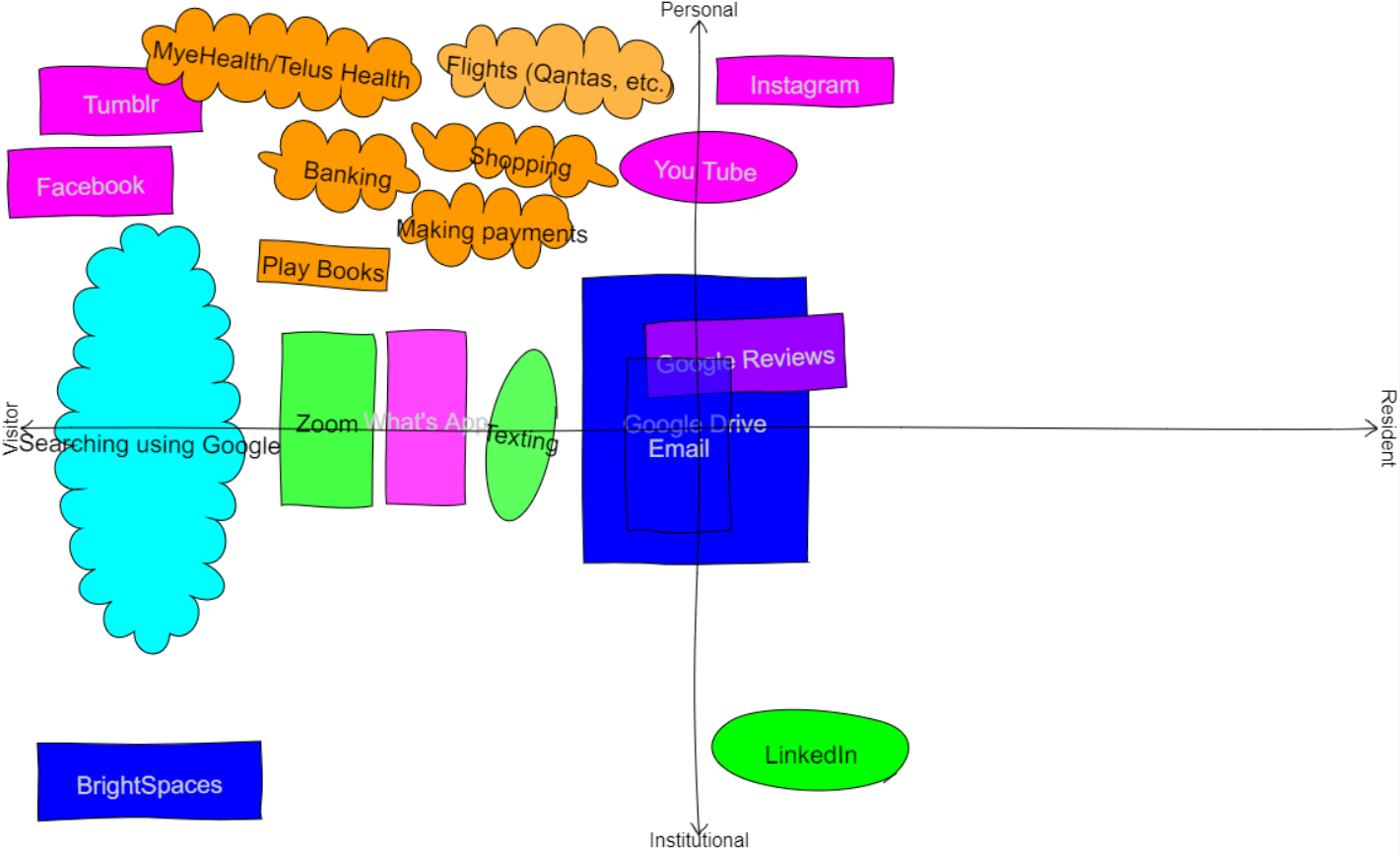
The digital platforms that students are currently using to develop their professional network are LinkedIn, Facebook, and Instagram. Typically across these three platforms, students will ‘follow’ organizations of interest, and will use social media to keep up to date on news and opportunities from these organizations. Typically weaker connections (Rajagopal, Joosten-ten Brinke and Van Bruggen) would be made through Facebook and Instagram by following organizations and certain individual’s pages.
On LinkedIn, there is more of an opportunity to build the strong connections necessary for active collaboration (Rajagopal, Joosten-ten Brinke and Van Bruggen) and to maintain a professional connection with others. It should be noted, however, that laying the groundwork for growing one’s PLN is most often done in person, and LinkedIn invites usually follow in-person communication.
To expand one’s professional learning network it can be useful to attend networking events and presentations in the community that are sponsored by organizations that are relevant to one’s interests. Another way to expand a professional learning network is by joining a club, (such as Toastmasters), taking a class, or by volunteering.
Within one’s personal learning network, digital identity/reputation can be created by working to achieve ‘digital residency’. Digital residency is a mode of engagement that views the web as a series of places. Being a digital resident means leaving a ‘social trace’. Most often digital residents go online to engage with others by being active on social media, joining in on discussions, commenting, and being socially present in email. I think that without leaving a ‘social trace’, it would be very difficult to form a digital identity/reputation. Others simply would not have enough information to make a judgment call on another’s perceived reputation.
It is now commonplace for employers to view an applicant’s social media in order to learn more about that candidate. Sometimes it is beneficial if this means by searching your name, an employer can easily view your LinkedIn page (provided that it is well maintained), find more information about community involvement, publications, etc. Public Instagram pages will also be visible which can either be beneficial or detrimental depending on what type of content is posted to it. If the content is considered appropriate, it could be a great way for an employer to get a better sense of an applicant’s personality. However, if the content is not appropriate, it could easily cost that applicant the opportunity to move forwards in the job application process. Something that I have personally noticed is that if there are too many applicants or if the individual or team doing the hiring is pressed for time, social media pages often do not get viewed, or are only viewed once the applicant pool has been reduced to a reasonable size.
A carefully constructed and well managed digital identity can certainly bring forward opportunities that may not have existed offline. Moving towards digital residency by becoming more comfortable with disclosing information, is a goal that I would love to work towards. It is clear to me by looking at my V&R diagram that I lean more towards being a digital visitor.
I have been hesitant to ‘put my thoughts out there’ for fear of judgment, but can now see how putting more effort into my digital identity and into building my PLN could connect me with potential opportunities employers, collaborators, and mentors. I tend to prefer to be engaged in the real world through networking events, lectures, volunteering, and hackathons in-person and would love to attend more events to help build my PLN (perhaps) in 2021 and beyond.
References
“Digital Visitor and Resident.” Wikipedia, Wikimedia Foundation, 31 Dec. 2020, https://en.wikipedia.org/wiki/Digital_Visitor_and_Resident.
Rajagopal, Kamakshi, et al. “Understanding personal learning networks: Their structure, content and the networking skills needed to optimally use them.” First Monday (2012). Web.
White, David. “V&R Mapping” David White: Digital-Learning-Culture. http://daveowhite.com/vandr/vr-mapping. Accessed 3 Feb. 2021.
Rachelle,
What a well thought out post. Your comment about how, “Digital residency is a mode of engagement that views the web as a series of places. Being a digital resident means leaving a ‘social trace’” truly gave new sense to my learning. Although I explain this in my V&R, I had not thought of using this language. You made it very clear and concise and I will absolutely use those terms in the posts to come.
I did note that you spoke to “the real world” as offline experiences. That language is always funny to me as online interactions are very much “real world” communications. I fear that breaking online and offline interactions into real and not real can affect how one might think about using online platforms as they may not think it will effect/ relate to their offline activities. I think about this in my profession as well. As an educator, we are truly trying to teach our students to be participants in the communities and the world in which they live and will be a part of developing. They will participate online, offline, in school, in their community and in nature. These contexts ALL take part in the “real world” and it is important, in my opinion, not to break them up so that learners recognize that learning relates to all contexts and that it is intertwined. I absolutely recognize how you intended on using the language. It is just the little thought in my head that stuck out and I felt the need to put that idea out there 🙂
Thank you again for your insightful post.
Hello Rachelle! This is a very insightful take on professional digital identity. I would say that just like you I also believe that it would be better to create my own professional network in the real world through attending events, lectures, volunteering, and etc. However, we should also be prepared to instances when we cannot do any face-to-face events. Just like what happened with the Covid-19 pandemic for example, nobody anticipated the gravity of the pandemic that we were forced to do everything online.